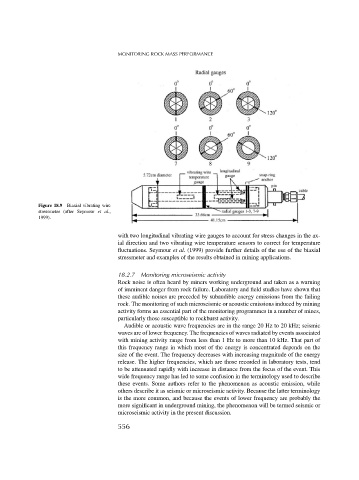Page 574 - Rock Mechanics For Underground Mining
P. 574
MONITORING ROCK MASS PERFORMANCE
Figure 18.9 Biaxial vibrating wire
stressmeter (after Seymour et al.,
1999).
with two longitudinal vibrating wire gauges to account for stress changes in the ax-
ial direction and two vibrating wire temperature sensors to correct for temperature
fluctuations. Seymour et al. (1999) provide further details of the use of the biaxial
stressmeter and examples of the results obtained in mining applications.
18.2.7 Monitoring microseismic activity
Rock noise is often heard by miners working underground and taken as a warning
of imminent danger from rock failure. Laboratory and field studies have shown that
these audible noises are preceded by subaudible energy emissions from the failing
rock. The monitoring of such microseismic or acoustic emissions induced by mining
activity forms an essential part of the monitoring programmes in a number of mines,
particularly those susceptible to rockburst activity.
Audible or acoustic wave frequencies are in the range 20 Hz to 20 kHz; seismic
waves are of lower frequency. The frequencies of waves radiated by events associated
with mining activity range from less than 1 Hz to more than 10 kHz. That part of
this frequency range in which most of the energy is concentrated depends on the
size of the event. The frequency decreases with increasing magnitude of the energy
release. The higher frequencies, which are those recorded in laboratory tests, tend
to be attenuated rapidly with increase in distance from the focus of the event. This
wide frequency range has led to some confusion in the terminology used to describe
these events. Some authors refer to the phenomenon as acoustic emission, while
others describe it as seismic or microseismic activity. Because the latter terminology
is the more common, and because the events of lower frequency are probably the
more significant in underground mining, the phenomenon will be termed seismic or
microseismic activity in the present discussion.
556

